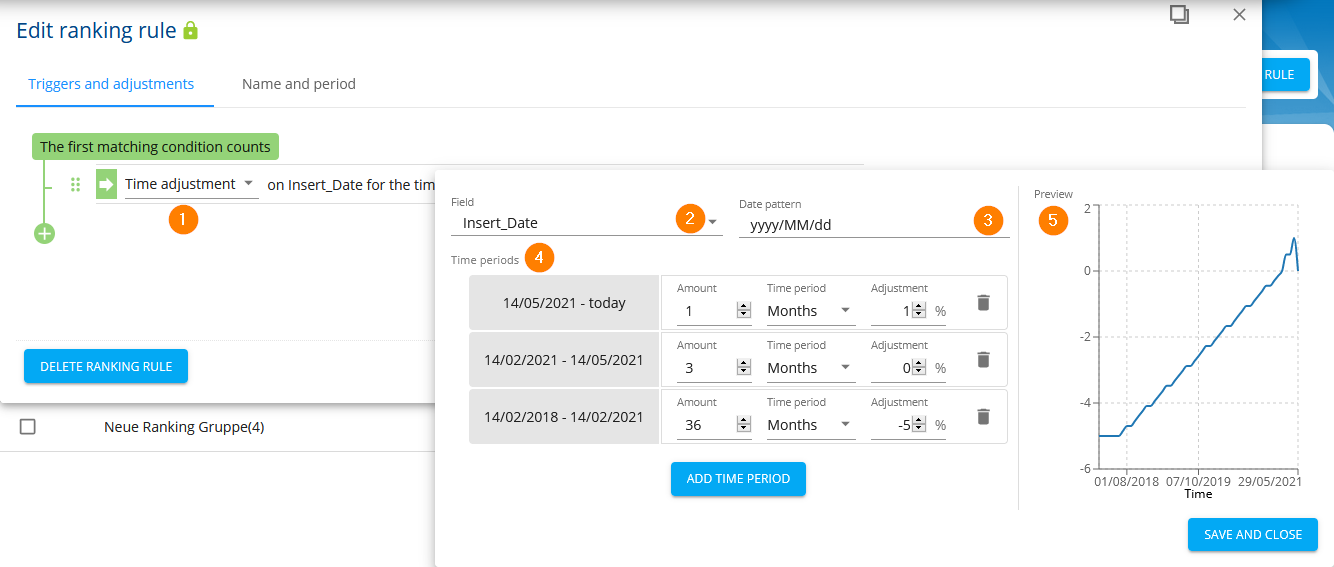Available Condition Types
Constant adjustment
With constant adjustment, the content of the selected field is compared with a criterion. If this criterion is met, the data record receives the defined increase or decrease in value or can be completely excluded from the search result.
In the following example, the manufacturer Adidas is upgraded by 2 %:
- Use the Field selection (1) to select the field from the data feed that contains the information to be used for the ranking.
- The Operator (2) defines the condition for the ranking. Different choices are available, depending on the field type (numeric or text field).
- Clicking on the field Value/Content (3) opens a dropdown that displays the first 2000 field contents of the selected field. This can be filtered by partially entering the content you are looking for.
- The Type of adjustment (4) field contains the selected condition type.
- The Effect (5) indicates the degree of adjusting up (positive values) or down (negative values). The value entered here is added to or subtracted from the score calculated for the individual items and thus influences the sorting of the items in the search results.
- To completely remove an item from the results, tick Exclude product (6) and leave the Effect (5) field empty.
Time adjustment
The time adjustment offers the possibility to revaluate or devaluate data records based on a date or time range.
If you want to use this condition type, a corresponding date field (e.g. creation date) must exist in your data. FACT-Finder checks the current date during import and calculates the difference.
To edit the configuration, you must first click on the Edit button, which appears when the mouse pointer hovers over the entry:
In the following example, new products (max. 1 month old) are revalued by 1 % and older products (older than 3 months) are devalued by 5 %:
- The Type of adjustment(1) field contains the selected condition type.
- Use the Field selection (2) to select the field from the data feed that contains the information to be used for ranking.
- In the field Date pattern (3) you can specify in which pattern (e.g. yyyy/mm/dd) the date in the corresponding field is passed.
- Under Time periods (4) you can define the up- or down-ranking for any number of periods in the past. The starting point is always today.
- You can define any intervals via the selection options Amount and Time period (day, week, month, year).
- Via Adjustment you define the revaluation (positive values) or devaluation (negative values). The value entered here is added to or subtracted from the score calculated for the individual items and thus influences the sorting of the items in the search result.
- The Preview (5) shows a graphic overview of the effect of the set values.
By defining several time ranges, you can also define an exponential revaluation or devaluation rule. In the same way, you can realise steps over changing time periods: 1-13 days with 0.01 % devaluation, 14 days 1 % devaluation. Then nothing happens for 13 days, after which it goes down significantly.
Value adjustment
The value adjustment is especially intended for numerical fields and offers the possibility to define a linear, logarithmic or stepwise gradation of the adjustment.
To edit the configuration, first click on the Edit button, which appears when the mouse pointer is over the entry (see → Time adjustment).
In the following example, products with good ratings (rating: 1-5 stars) are upgraded by up to 3 %:
- The Type of adjustment (1) field contains the selected condition type.
- Use the Field selection (2) to select the field from the data feed that contains the information to be used for ranking.
- The Mode of adjustment (3) determines whether the gradation should be linear, logarithmic or stepwise.
- The Top value (4) and Worst value (5) define the range in which the condition should take effect. The choice of values depends on the value range of the field and the goal of the ranking.
- The Adjustment (6) specifies the degree of upgrading (positive values) or downgrading (negative values). The value entered here is added to or subtracted from the score calculated for the individual items and thus influences the sorting of the items in the search result.
- The Preview (7) shows a graphic overview of the effect of the set parameters.
NEW in FACT-Finder NG



